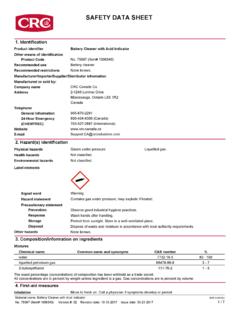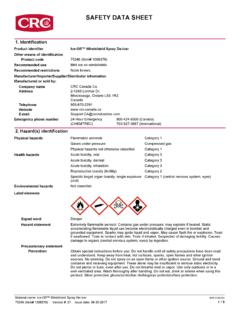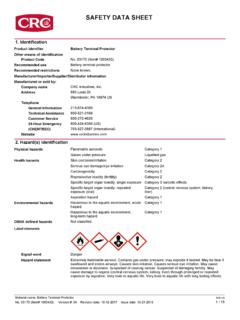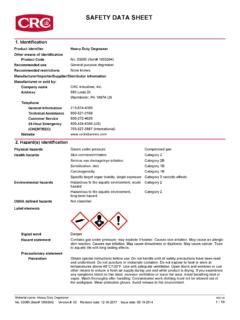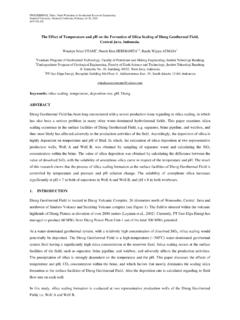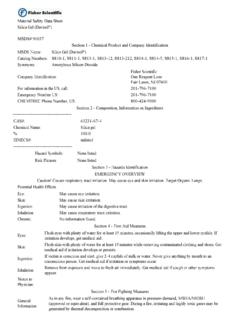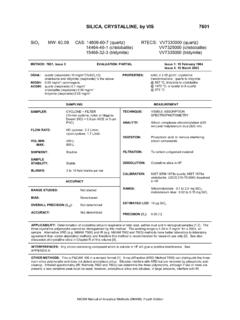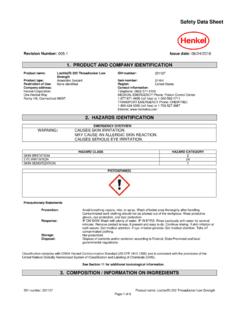Transcription of SAFETY DATA SHEET - CRC Industries
1 SAFETY data SHEET . 1. Identification Product identifier RTV Silicone Sealant - Clear (pressurized). Other means of identification Product code 14055. Recommended use Sealant and adhesive Recommended restrictions None known. Manufacturer/Importer/Supplier/Distribut or information Manufactured or sold by: Company name CRC Industries , Inc. Address 885 Louis Dr. Warminster, PA 18974 US. Telephone General Information 215-674-4300. Technical 800-521-3168. Assistance Customer Service 800-272-4620. 24-Hour Emergency 800-424-9300 (US). (CHEMTREC) 703-527-3887 (International). Website 2. Hazard(s) identification Physical hazards Gases under pressure Compressed gas Health hazards Skin corrosion/irritation Category 2. Serious eye damage/eye irritation Category 2B. Environmental hazards Hazardous to the aquatic environment, acute Category 3.
2 Hazard Hazardous to the aquatic environment, Category 3. long-term hazard OSHA defined hazards Not classified. Label elements Signal word Warning Hazard statement Contains gas under pressure; may explode if heated. Causes skin irritation. Causes eye irritation. Harmful to aquatic life. Harmful to aquatic life with long lasting effects. Precautionary statement Prevention Do not puncture or incinerate container. Do not expose to heat or store at temperatures above 49 C/120 F. Use with adequate ventilation. Open doors and windows or use other means to ensure a fresh air supply during use and while product is drying. If you experience any symptoms listed on this label, increase ventilation or leave the area. Wash hands thoroughly after handling. Wear protective gloves. Avoid release to the environment. Response If on skin: Wash with plenty of water.
3 If skin irritation occurs: Get medical attention. Take off contaminated clothing and wash before reuse. If in eyes: Rinse cautiously with water for several minutes. Remove contact lenses, if present and easy to do. Continue rinsing. If eye irritation persists: Get medical attention. Storage Protect from sunlight. Store in a well-ventilated place. Exposure to high temperature may cause can to burst. Disposal Dispose of contents/container in accordance with local/regional/national regulations. Hazard(s) not otherwise None known. classified (HNOC). Material name: RTV Silicone Sealant - Clear (pressurized) SDS US. 1008 Version #: 01 Issue date: 12-04-2013 1/8. Supplemental information When heated to temperature above 300 F/150 C in the presence of air, product may form formaldehyde vapors. When exposed to water or humid air, product evolves acetic acid (HOAc).
4 Of the mixture consists of component(s) of unknown acute hazards to the aquatic environment. of the mixture consists of component(s) of unknown long-term hazards to the aquatic environment. 3. Composition/information on ingredients Mixtures Chemical name Common name and synonyms CAS number %. Polydimethylsiloxane, 70131-67-8 >= 70. hydroxy-terminated Amorphous silica 7631-86-9 7 - 13. Distillates (petroleum), 64742-46-7 5 - 10. Hydrotreated Middle Ethyltriacetoxysilane 17689-77-9 1-5. Methyltriacetoxysilane 4253-34-3 1-5. Polydimethylsiloxane 63148-62-9 1-5. Nitrogen 7727-37-9 1-3. Specific chemical identity and/or percentage of composition has been withheld as a trade secret. 4. First-aid measures Inhalation Move to fresh air. Get medical attention immediately. Skin contact Remove contaminated clothing immediately and wash skin with soap and water.
5 If skin irritation occurs: Get medical advice/attention. Take off contaminated clothing and wash before reuse. Eye contact Immediately flush eyes with plenty of water for at least 15 minutes. Remove contact lenses, if present and easy to do. Continue rinsing. Get medical attention if irritation develops and persists. Ingestion Rinse mouth. Get medical attention. Most important Irritation of eyes and mucous membranes. Exposed individuals may experience eye tearing, symptoms/effects, acute and redness, and discomfort. Skin irritation. May cause redness and pain. delayed Indication of immediate Provide general supportive measures and treat symptomatically. Keep victim under observation. medical attention and special Symptoms may be delayed. treatment needed General information Ensure that medical personnel are aware of the material(s) involved, and take precautions to protect themselves.
6 5. Fire-fighting measures Suitable extinguishing media Water. Dry chemical, CO2, or water spray. Unsuitable extinguishing None known. media Specific hazards arising from Contents under pressure. During fire, gases hazardous to health may be formed. When heated to the chemical temperature above 300 F/150 C in the presence of air, product may form formaldehyde vapors. When exposed to water or humid air, product evolves acetic acid (HOAc). Special protective equipment Firefighters must use standard protective equipment including flame retardant coat, helmet with and precautions for firefighters face shield, gloves, rubber boots, and in enclosed spaces, SCBA. Wear self-contained breathing apparatus and protective clothing. Fire-fighting In case of fire: Stop leak if safe to do so. Do not move cargo or vehicle if cargo has been exposed equipment/instructions to heat.
7 Containers should be cooled with water to prevent vapor pressure build up. For massive fire in cargo area, use unmanned hose holder or monitor nozzles, if possible. If not, withdraw and let fire burn out. In the event of fire, cool tanks with water spray. 6. Accidental release measures Personal precautions, Keep unnecessary personnel away. Keep people away from and upwind of spill/leak. Keep out of protective equipment and low areas. Use a positive-pressure air-supplied respirator if there is any potential for an emergency procedures uncontrolled release, exposure levels are not known, or any other circumstances where air-purifying respirators may not provide adequate protection. Wear appropriate protective equipment and clothing during clean-up. Do not touch damaged containers or spilled material unless wearing appropriate protective clothing.
8 Ensure adequate ventilation. Local authorities should be advised if significant spillages cannot be contained. For personal protection, see section 8 of the SDS. Material name: RTV Silicone Sealant - Clear (pressurized) SDS US. 1008 Version #: 01 Issue date: 12-04-2013 2/8. Methods and materials for Eliminate all ignition sources (no smoking, flares, sparks, or flames in immediate area). Keep containment and cleaning up combustibles (wood, paper, oil, etc.) away from spilled material. Stop the flow of material, if this is without risk. Dike far ahead of spill for later disposal. Shovel up and place in a container for salvage or disposal. Final cleaning may require use of steam, solvents or detergents. Dispose of saturated absorbent or cleaning materials appropriately, since spontaneous heating may occur. Prevent entry into waterways, sewer, basements or confined areas.
9 For waste disposal, see section 13 of the SDS. Environmental precautions Avoid release to the environment. Contact local authorities in case of spillage to drain/aquatic environment. Prevent further leakage or spillage if safe to do so. Do not contaminate water. Avoid discharge into drains, water courses or onto the ground. 7. Handling and storage Precautions for safe handling Pressurized container: Do not pierce or burn, even after use. Do not use if spray nozzle is missing or defective. Do not spray on a naked flame or any other incandescent material. Do not smoke while using or until sprayed surface is thoroughly dry. Do not cut, weld, solder, drill, grind, or expose containers to heat, flame, sparks, or other sources of ignition. Avoid breathing vapor. Avoid contact with skin. Avoid contact with eyes. Avoid contact with clothing.
10 Use only in well-ventilated areas. When heated to temperature above 300 F/150 C in the presence of air, product may form formaldehyde vapors. When exposed to water or humid air, product evolves acetic acid (HOAc). Wear appropriate personal protective equipment. Wash hands thoroughly after handling. Observe good industrial hygiene practices. Avoid release to the environment. Do not empty into drains. For product usage instructions, please see the product label. Conditions for safe storage, Level 1 Aerosol. including any incompatibilities Keep container closed and store away from water or moisture. Contents under pressure. Do not expose to heat or store at temperatures above 120 F/49 C as can may burst. Do not puncture, incinerate or crush. Do not handle or store near an open flame, heat or other sources of ignition.



